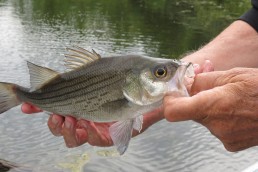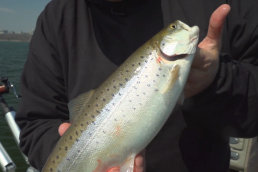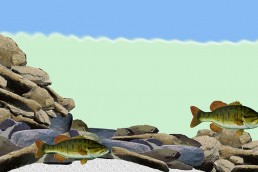Carlyle Lake Spring White Bass
SHARE THIS POST
During spring, white bass move to staging areas and then into the spawning areas of lakes and rivers. This produces a variety of opportunities for the angler. The exact dates of the white bass action are dependent upon water temperature and levels in the main lake.
Carlyle Lake offers some of the best white bass fishing in terms of quantity and quality. The fish average 2/3 pounds in size and there are good quantities available.
Located on the Kaskaskia River near Carlyle, Illinois, the lake is 50 miles due east of St. Louis in Fayette, Bond and Clinton counties. It is a U.S. Army Corps of Engineers reservoir that contains some 26,000 acres of water. White bass are scattered throughout it.
White bass are a cousin of the saltwater striped bass and, as such, have much of the savage instinct of their brethren. They will hit light tackle and give anglers more than they can handle.
Following the warm rains of April, these water tigers go on a feeding frenzy that will last into June. White bass become more active as the water temperature rises above 50 degrees. Once above 58 degrees, the fish move out of the staging areas and into the spawning areas.
The average size taken by anglers tends to run about 3/4 of a pound, with some taken over two pounds.
Catching white bass is easy; finding them is the tough part. Pre-spawn fish position on sand bars and gravel banks in fast water. During the spawn, they make runs into major feeder streams looking for suitable gravel beds. After the spawn, they head downstream into creek channels or roam out into the main body of water.
If the fish are not yet feeling the spawning stages, then a good pattern is to troll over sunken islands and humps with small crankbaits. The presence of feeding gulls is a good sign of white bass feeding locations. Look for sign of shad clouds on your electronics; the schools of white bass are usually nearby. Often, they can be found on the deeper side of the islands or flats. They are waiting to ambush some hapless shad that might swim past.
White bass are active fish that feed constantly. Whites prefer to spend their time in water deeper than 10 feet but will often move into the shallows to feed. Their favorite meal is shad. A sure sign of white bass presence is water that appears to be boiling. This is caused by shad breaking the surface to outrun the bass.
Sauger often travel with white bass in spring. White bass anglers often take a sauger or two at the same time.
Are you enjoying this post?
You can be among the first to get the latest info on where to go, what to use and how to use it!
When feeding on the surface, concentrations of seagulls pinpoint the location for the angler. At close range, find them by spotting the splashing water caused by the feeding fish breaking the surface. At times, the fish will stay up for ten to fifteen minutes. More often, they will feed for only a minute or two and then dive back down. Usually they will surface again a hundred yards or so away.
As the water warms, look for fish out on the main lake. If the water cools, then check creek mouths or the flats. In-line spinners and jig/minnow combinations are good choices when fishing riprap areas.
Early morning and late evening hours are the best to find white bass. But when they are actively feeding, they can be caught in the heat of the day. Position your boat in the general area of the feeding and wait for the white bass to rise. If you want to get out of the direct sunlight, anchor under bridges to wait for the action.
Light tackle is a must for these fish. Small crankbaits, spinners and jigs are good with line in the 4- to 8-pound test range. So are small tube jigs tipped with a minnow or a plastic grub. Plastics with contrasting dark and light colors work well. White plastics are popular.
Lures can be double rigged for more action. A pod of fish will often yield multiple strikes.
Astute anglers will notice the size of the baitfish and match lures to them. Angling success tends to be dependent on year hatches. A year with incredible numbers can help carry the population over lean years. The best fishing is likely to be about two years after a large year hatch.
For more information…
Fishing on Carlyle Lake and local accommodations, contact the Illinois Department of Natural Resources, Hazlet State Park, R.R. #3, Carlyle, Illinois 62231; 618-594-3015.
MWO
SHARE THIS POST
Did you enjoy this post?
You can be among the first to get the latest info on where to go, what to use and how to use it!
Don Gasaway
Don Gasaway is a veteran freelance outdoor writer from Marion, Ill. He may also be found at: https://www.facebook.com/DonGasawayWriter and facebook.com/Wandering Angler. Comments are welcome



